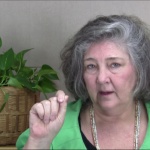This advice-column-style blog for SLPs was authored by Pam Marshalla from 2006 to 2015, the archives of which can be explored here. Use the extensive keywords list found in the right-hand column (on mobile: at the bottom of the page) to browse specific topics, or use the search feature to locate specific words or phrases throughout the entire blog.
Again: What Does Oral Motor Therapy Have To Do With Speech?
By Pam Marshalla
 Q: What does oral motor therapy have to do with speech?
Q: What does oral motor therapy have to do with speech?
I want to take another run at this question because it arises so often. Consider:
Phonemes emerge when a child’s oral-motor control is immature. Think about [b], [d] and [g]. These early voiced stops emerge when a child is about 6 months of age. That means that the oral movements used during their production are primitive. These primitive movements refine over time.
From an oral-motor perspective, we can say that all phonemes have three forms in development:
- An “Emergent Form” – This is the way a phoneme is produced when it first emerges
- A “Maturation Form” – This is the way it sounds as oral-motor skills mature
- An “Adult Form” – This is the way a phoneme sounds when it is produce with full motor maturation
The Consonant Chart and Vowel Quadrilateral have been constructed based upon the Adult Form. After all, it was adults who were studied when these tools were created.
BUT CHILDREN DO NOT PRODUCE PHONEMES WITH MATURITY UNTIL THEIR MOTOR SYSTEM REACHES MATURITY. Until then, their phonemes are made with oral-motor immaturity. That is what makes the way a toddler says R, L, S and other phonemes so adorable.
Some of our clients speak with immature speech patterns because their oral movement system is still immature. Many of these clients demonstrate immaturity in other parts of the body too.
Other clients speak incorrectly because their oral movement system is impaired due to structural deficit or neuromuscular disorder.
The oral-motor analysis reveals the level of oral movement maturation. It also reveals incorrect oral movement that impacts speech.
Oral-motor therapy is designed to mature the oral-motor system so that phonemes can be spoken with mature oral movements.
